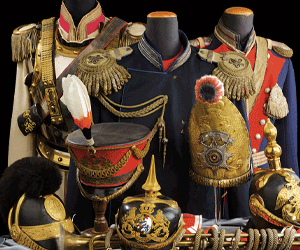HJ 1933 Pattern Obergebietsführer Shoulder Boards
SKU: 31.GOR.03.02.02.01.01.002
Estimated market value:

Estimated market value:
Attributes
History
Shoulder boards in the Hitler Youth identified the wearer’s rank and deployment. They were first standardised in 1933 and worn on both shoulders. Lower ranks wore shoulder straps, while leader ranks wore the stiffer shoulder boards. For the sake of simplicity, the term “shoulder boards” will be used to refer to both from here on.
The shoulder boards for the specialised HJ sub-groups will be shown in the 1938 pattern unless otherwise indicated. Early shoulder boards were generally in brown, while those worn after 1938 were black.
Before 1933, shoulder boards with dual-coloured piping were worn, probably following the SA Landesfarben (regional colours) system. Rank pip placement during this time was very variable.
The shoulder boards introduced in 1933 measured 125x40mm plus 2mm piping on each side if any was worn. These shoulder boards were pointed at the neck.
Piping reflected membership in one of six Oberbanne (transregional areas). Oberbann colours were as follows:
Oberbann 1: red
Oberbann 2: yellow
Oberbann 3: green
Oberbann 4: blue
Oberbann 5: black
Oberbann 6: white
Shoulder boards for higher ranks instead featured twist cord piping in gold or silver, depending on the wearer’s rank.
The shoulder board button was generally pebbled. Its colour depended on the wearer’s rank. Gold-coloured buttons were used for higher leaders, silver-coloured ones for leader ranks, and grey ones for lower ranks. Buttons for lower ranks may or may not feature an Arabic number from 1 to 4 for the wearer’s Gefolgschaft (battalion). This was eventually discontinued.
Below the button, the wearer’s Bann (regional unit) number was added to the shoulder board. It was generally chain-stitched onto the board. The Bann number is in Arabic numerals and in the colour of the wearer’s Oberbann. Below it the Unterbann (sub-unit) number in Roman numerals from I to V was placed, in the same colour.
Rank pips were in the shape of four-sided stars, either silver or gold-coloured, depending on the rank of the wearer. When he wore silver-coloured buttons, the rank stars were silver-coloured as well, and the same for gold-coloured buttons and stars. The rank stars were placed below the Bann and Unterbann numbers.
The highest ranks (Stabsführer down to Bannführer) featured hand-embroidered oak leaves, either gold or silver-coloured, following the same colour scheme as above.
Ranks were as follows:
Stabsführer: crimson shoulder boards with three gold-coloured oak leaves and two acorns, as well as two gold-coloured pips and gold-coloured piping. (Initially, one star was placed above and one below the oak leaves, but as of April of 1935, both were positioned below and arranged horizontally.)
Obergebietsführer: crimson shoulder boards with three gold-coloured oak leaves and two acorns, as well as one gold-coloured pip and gold-coloured piping.
Gebietsführer: red shoulder boards with three silver-coloured oak leaves and two acorns, piping in silver.
Oberbannführer: yellow shoulder boards with two silver-coloured oak leaves and acorns, piping in silver. (On November 24, 1934 it was decided that Oberbannführer as Leaders of a Bann were to wear white shoulder boards with two-silver coloured oak leaves and the Bann number above, as well as a silver-coloured button and silver-coloured twist cord piping, while Oberbannführer as Leaders of a Gebiet (region) were to wear red shoulder boards with silver-coloured oak leaves, button, and twist cord piping.)
Bannführer: white shoulder boards with one silver-coloured oak leaf and one acorn. Piping and Bann number were in Oberbann colour.
All following shoulder boards are light brown:
Unterbannführer: four silver-coloured pips, forming a square.
Gefolgschaftsführer: three silver-coloured pips, one above two.
Scharführer: two silver-coloured pips, arranged horizontally.
Kameradschaftsführer: one silver-coloured pip.
Rottenführer (introduced on November 24, 1934): one silver-coloured bar at the base.
Hitlerjunge: no additional rank indicators
Ranks of Obergebietsführer down to Bannführer on a staff wore carmine shoulder boards with a gold-coloured (Obergebietsführer), silver-coloured (Gebietsführer and Oberbannführer), or white (Bannführer) Oberbann number.
Those serving on the staff of the Reichsjugendführung (National Youth Leadership) wore light red shoulder boards with a gold-coloured Oberbann number.
On November 24, 1934 a few changes were implemented. The shoulder board colour for the Abteilungsleiter (departmental leader) at the Reichsjugendführung, the Stabsführer (staff leader), and the personal adjutant of the Reich Youth Leader were changed from carmine to red.
The ranks of Obergebietsführer down to Bannführer on all staffs other than that of the Reichsjugendführung were to wear carmine shoulder boards with silver-coloured cyphers, buttons, and piping, while those on the staff of the Reichsjugendführung wore carmine shoulder boards with gold-coloured cyphers, buttons, and piping.
Some shoulder boards featured embroidered letters in Oberbann/branch colour. Letters that can be encountered are the following:
B (Gothic letter): Bann (discontinued after 1936)
OB (Gothic letters): Oberbann (discontinued after 1936)
OG (Gothic letters): Obergebiet (discontinued after 1936)
A: Akademie (Reich Youth Leadership academy): silver
AHS: Adolf Hitler Schools: red for students, silver for leaders
NPEA: Nationalpolitische Erziehungsanstalten (National Political Institutes of Education): white
RFS: Reichsführerschule (Reich Leader School): red
RJF: staff of the Reichsjugendführung (Reich Youth Leadership)
B: Blinde (blind members): initially black on brown, then red on black
G: Hörgeschädigte (deaf or hard-of-hearing members): initially black on brown, then red on black
BS: Binnenschifffahrt (inland waterways): yellow
S: Seeschifffahrt (sea-going units): yellow
L (Gothic letter): Landjahr (rural community service): green
L: Bann München (Munich)
J: Bann Nürnberg (Nuremberg)
RS: Rundfunk-Spielscharen (broadcasting units): red
W: Wachgefolgschaft (guard unit) “Baldur von Schirach”: carmine


Comments
Sign in to comment and reply.


Scroll Top